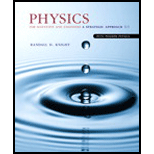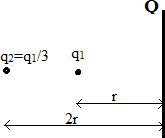
Concept explainers
a. Charge q1is distance r from a positive point charge Q. Charge q2= q1/3 is distance 2r from Q. What is the ratio U1/U2 of their potential energies due to their interactions with Q? b. Charge q1is distance s from the negative plate of a parallel-plate capacitor. Charge q2= q1/3 is distance 2s from the negative plate. What is the ratio U1/U2 of their potential energies?
a. Ratio of potential energy
b. Ratio of potential energy
Answer to Problem 1CQ
Solution:
a. Ratio of the potential energy is
b. Ratio of the potential energy is
Explanation of Solution
Given:
(a)
Charge
Charge
(b)
Charge
Charge
Formula used:
The potential energy of the charge particle is given by the formula
Here,
Calculation:
(a)
Consider the diagram of the charge particles

Figure.1
The potential energy of the charge particle
The potential energy of the charge particle
Plugging the values in the above equation
Calculate the ratio of the potential energy by dividing Eq. (1) by Eq. (2)
Hence the ration of their potential energy is
(b)
Consider the diagram of the charge particles

Figure.1
The potential energy of the charge particle
Plugging the values in the above equation
The potential energy of the charge particle
Plugging the values in the above equation
Calculate the ratio of the potential energy by dividing Eq. (3) by Eq. (4)
Hence the ration of their potential energy is
Conclusion:
a. Ratio of the potential energy is
b. Ratio of the potential energy is
Want to see more full solutions like this?
Chapter 25 Solutions
Physics for Scientists and Engineers: A Strategic Approach with Modern Physics (4th Edition)
Additional Science Textbook Solutions
The Cosmic Perspective (8th Edition)
Conceptual Integrated Science
Conceptual Physics (12th Edition)
Physics for Scientists and Engineers
Essential University Physics: Volume 1 (3rd Edition)
- A parallel-plate capacitor with capacitance C0 stores charge of magnitude Q0 on plates of area A0 separated by distance d0. The potential difference across the plates is V0. If the capacitor is attached to a battery and the charge is doubled to 2Q0, what are the ratios (a) Cnew/C0 and (b) Vnew/V0? A second capacitor is identical to the first capacitor except the plate area is doubled to 2A0. If given a charge of Q0, what are the ratios (c) Cnew/C0 and (d) Vnew/V0? A third capacitor is identical to the first capacitor, except the distance between the plates is doubled to 2d0. If the third capacitor is then given a charge of Q0, what are the ratios (e) Cnew/C0 and (f) Vnew/V0?arrow_forwardThree particles with equal positive charges q are at the corners of an equilateral triangle of side a as shown in Figure P20.10. (a) At what point, if any, in the plane of the particles is the electric potential zero? (b) What is the electric potential at the position of one of the particles due to the other two particles in the triangle? Figure P20.10arrow_forward(a) What is the capacitance of a parallel plate capacitor having plates of area 1.50 m2 that are separated by 0.0200 mm of neoprene rubber? (b) What charge does it hold when 9.00 V is applied to it?arrow_forward
- A research Vail de Graaff generator has a 2.00-m- diameter metal sphere with a charge of 5.00 mC on it. (a) What is the potential near its surface? (b) At what distance from its center is the potential 1.00 MV? (c) An oxygen atom with three missing electrons is released near the Van de Graaff generator. What is its energy in MeV when the atom is at the distance found in part b?arrow_forwardA parallel-plate capacitor with capacitance C0 stores charge of magnitude Q0 on plates of area A0 separated by distance d0. The potential difference across the plates is V0. If the capacitor is attached to a battery and the charge is doubled to 2Q0, what are the ratios (a) Cnew/C0 and (b) Vnew/V0? A second capacitor is identical to the first capacitor except the plate area is doubled to 2A0. If given a charge of Q0, what are the ratios (c) Cnew/C0 and (d) Vnew/V0? A third capacitor is identical to the first capacitor, except the distance between the plates is doubled to 2d0. If the third capacitor is then given a charge of Q0, what are the ratios (e) Cnew/C0 and (f) Vnew/V0?arrow_forward(a) Plot the potential of a uniformly charged 1-m rod with 1 C/m charge as a function of the perpendicular distance from the center. Draw your graph from s = 0,1 in to s = 1.0m. (b) On the same graph, plot the potential of a point charge with a 1-C charge at the origin, (c) Which potential is stronger near the rod? (d) What happens to the difference as the distance increases? Interpret your result.arrow_forward
- A small spherical pith ball of radius 0.50 cm is painted with a silver paint and then -10 C of charge is placed on it. The charged pith ball is put at the center of a gold spherical shell of inner radius 2.0 cm and outer radius 2.2 cm. (a) Find the electric potential of the gold shell with respect to zero potential at infinity, (b) How much charge should you put on the gold shell if you want to make its potential 100 V?arrow_forwardAn electron is at the origin, (a) Calculate the electric potential VA at point A, x = 0.250 cm. (b) Calculate the electric potential VB at point B, x = 0.750 cm. What is the potential difference VB VA? (c) Would a negatively charged particle placed at point A necessarily go through this same potential difference upon reaching point B? Explain.arrow_forwardA positive point charge q = +2.50 nC is located at x = 1.20 m and a negative charge of 2q = 5.00 nC is located at the origin as in Figure P16.18. (a) Sketch the electric potential versus x for points along the x-axis in the range 1.50 m x 1.50 m. (b) Find a symbolic expression for the potential on the x-axis at an arbitrary point P between the two charges. (c) Find the electric potential at x = 0.600 m. (d) Find the point along the x-axis between the two charges where the electric potential is zero.arrow_forward
- (a) What is the potential between two points situated 10 cm and 20 cm from a 3.0 C point charge? (b) To what location should the point at 20 cm be moved to increase this potential difference by a factor of two?arrow_forwardA rod of length L (Fig. P20.26) lies along the x axis with its left end at the origin. It has a nonuniform charge density = x, where is a positive constant. (a) What are the units of ? (b) Calculate the electric potential at A. Figure P20.26arrow_forwardA research Van de Graaff generator has a 2.00-rn- diameter metal sphere with a charge of 5.00 mC on it. (a) What is the potential near its surface? (b) At what distance from its center is the potential 1.00 MV? (C) An oxygen atom with three missing electrons is released near the Van de Graatf generator. What is its energy in MeV at this distance?arrow_forward
 Physics for Scientists and Engineers, Technology ...PhysicsISBN:9781305116399Author:Raymond A. Serway, John W. JewettPublisher:Cengage Learning
Physics for Scientists and Engineers, Technology ...PhysicsISBN:9781305116399Author:Raymond A. Serway, John W. JewettPublisher:Cengage Learning Physics for Scientists and Engineers with Modern ...PhysicsISBN:9781337553292Author:Raymond A. Serway, John W. JewettPublisher:Cengage Learning
Physics for Scientists and Engineers with Modern ...PhysicsISBN:9781337553292Author:Raymond A. Serway, John W. JewettPublisher:Cengage Learning Physics for Scientists and EngineersPhysicsISBN:9781337553278Author:Raymond A. Serway, John W. JewettPublisher:Cengage Learning
Physics for Scientists and EngineersPhysicsISBN:9781337553278Author:Raymond A. Serway, John W. JewettPublisher:Cengage Learning College PhysicsPhysicsISBN:9781305952300Author:Raymond A. Serway, Chris VuillePublisher:Cengage Learning
College PhysicsPhysicsISBN:9781305952300Author:Raymond A. Serway, Chris VuillePublisher:Cengage Learning College PhysicsPhysicsISBN:9781285737027Author:Raymond A. Serway, Chris VuillePublisher:Cengage Learning
College PhysicsPhysicsISBN:9781285737027Author:Raymond A. Serway, Chris VuillePublisher:Cengage Learning





